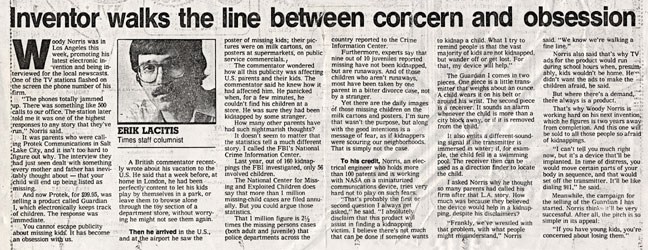
Times

Inventor walks the line between concern and obsession
by Erik Lacitis, Time Staff Columnist
Woody Norris was in Los Angeles this week, promoting his latest electronic invention and being interviewed for the local newscasts. One of the TV stations flashed on the screen the phone number of his firm.
"The phone totally jammed up. There was something like 500 calls to our office. The station later told me it was one of the highest responses to any story that they've run," Norris said.
It was parents who were calling Protek Communications in Salt Lake City, and it wasn't too hard to figure out why. The interview they had just seen dealt with something every mother and father has inevitably thought about--that your child will end up being listed as missing.
And now Protek, for $99.95, was selling a product called Guardian I, which electronically keeps track of children. The response was immediate.
You cannot escape publicity about missing kids. It has become an obsession with us.
A British commentator recently wrote about his vacation to the U.S. He said that a week before, at home in London, had had been perfectly content to let his kids play by themselves in a park, or leave them to browse alone through the toy section of a department store, without worrying he might not see them again.
Then he arrived in the U.S., and at the airport he saw the poster of missing kids; their pictures were on milk cartons, on posters at supermarkets, on public service commercials.
The commentator wondered how all this publicity was affecting U.S. parents and their kids. The commentator said he knew how it had affected him. He panicked when, for a few minutes, he couldn't find his children at a store. He was sure they had been kidnapped by some stranger.
How many other parents have had such nightmarish thoughts?
It doesn't seem to matter that the statistics tell a much different story. I called the FBI's National Crime Information Center.
Last year, out of 160 kidnappings the FBI investigated, only 56 involved children.
The National Center for Missing and Exploited Children does say that more than 1 million missing-child cases are filed annually. But you could argue those statistics.
That 1 million figure is 2 1/2 times the missing persons cases (both adult and juvenile) that police departments across the country reported to the Crime Information Center.
Furthermore, experts say that nine out of 10 juveniles reported missing have not been kidnapped, but are runaways. And of those children who aren't runaways, most have been taken by one parent in a bitter divorce case, not by a stranger.
Yet there are the daily images of those missing children on the milk cartons and posters. I'm sure that wasn't the purpose, but along with the good intentions is a message of fear, as if kidnappers were scouring our neighborhoods. That is simply not the case.
To his credit, Norris, an electrical engineer who holds more than 100 patents and is working with NASA on a miniaturized communications device, tries very hard not to play on such fears.
"That's probably the first or second question I always get asked," he said. "I absolutely disclaim that this product will assist in finding a kidnapping victim. I believe there's not much that can be done if someone wants to kidnap a child. What I trie to remind people is that the vast majority of kids are not kidnapped but wander off or get lost. For that, my device will help."
The Guardian I comes in two pieces. One piece is a little transmitter that weighs about an ounce. A child wears it on his belt or around his wrist. The second piece is a receiver. It sounds an alarm whenever the child is more than a city block away, or if it is removed from the child.
It also emits a different-sounding signal if the transmitter is immersed in water; if, for example, the child fell in a swimming pool. The receiver then can be used as a direction finder to locate the child.
I asked Norris why he thought so many parents had called his firm after that L.A. story. How much was because they believed the device would help in a kidnapping, despite his disclaimers?
"Frankly, we've wrestled with that problem, with what people might misunderstand," Norris said. "We know we're walking a fine line."
Norris also said that's why TV ads for the product would run during school hours when, presumably, kids wouldn't be home. He didn't want the ads to make the children afraid, he said.
But where there's a demand, there always is a product.
That's why Woody Norris is working hard on his next invention, which he figures is two years away from completion. And this one will be sold to all those people so afraid of kidnappings.
"I can't tell you much right now, but it's a device that'll be implanted. In time of distress, you would move certain parts of your body in sequence, and that would set off the transmitter. It'll be like dialing 911," he said.
Meanwhile, the campaign for the selling of the Guardian I has started. Norris thinks it'll be very successful. After all, the pitch is so simple in its appeal:
"If you have young kids, you're concerned about losing them."

Contact Webmaster
Copyright © 2001-2005 Woody Norris. All rights
reserved.
Revised: September 29, 2005